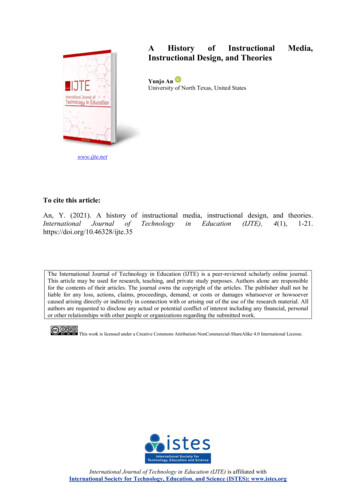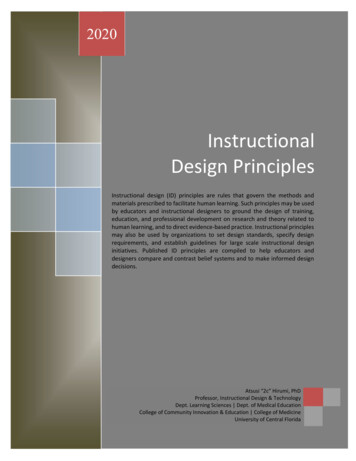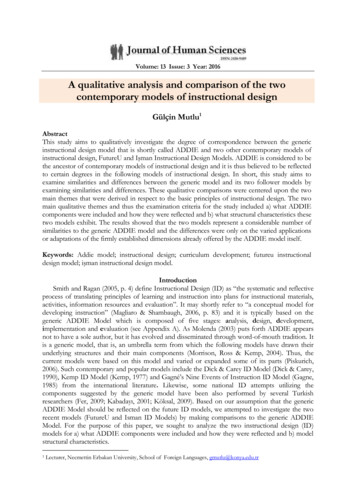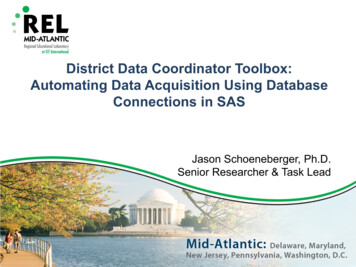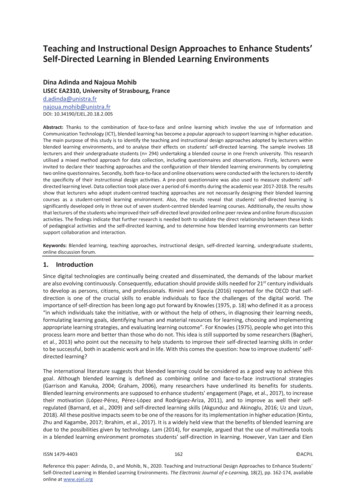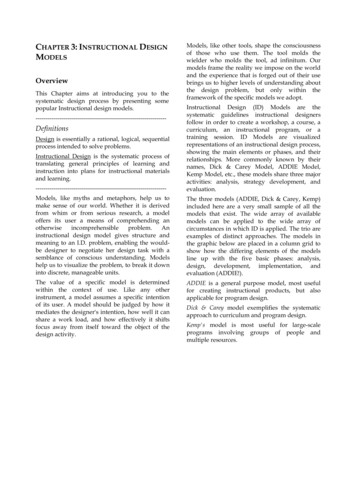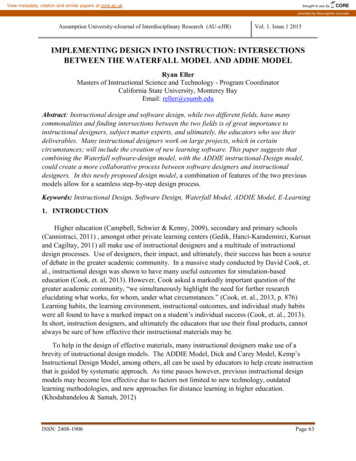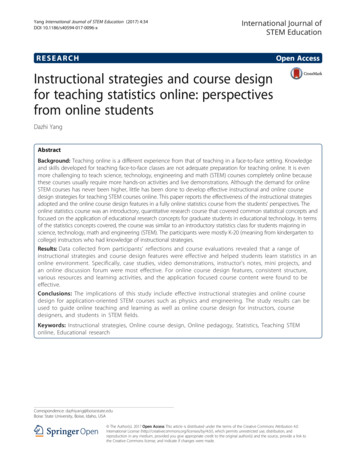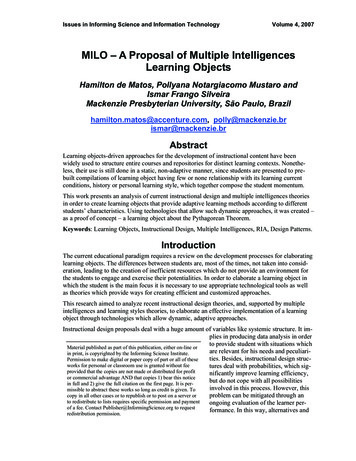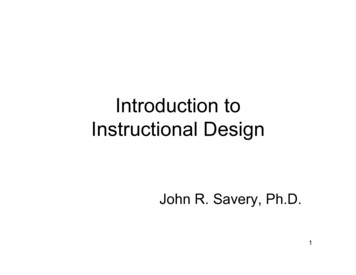
Transcription
P1: MRM/FYXPB378-26P2: MRM/UKSPB378-Jonassen-v3.clsQC: MRM/UKST1: MRMAugust 30, 200314:25Char Count 0AUTOMATING INSTRUCTIONAL DESIGN:APPROACHES AND LIMITATIONSJ. Michael Spector and Celestia OhrazdaSyracuse University26.1 INTRODUCTION26.2 HISTORICAL OVERVIEWIn the last half of the previous century, many tasks that hadbeen regarded as best accomplished by skilled workers havebeen shifted partially or entirely to computers. Examples can befound in nearly every domain, including assembly line operations, quality control, and financial planning. As technologiesand knowledge have advanced, the tasks of scientists, engineers, and managers have become considerably more complex.Not surprisingly, there has been a tendency to apply computertechnologies to the more complex and challenging tasks encountered by the user. Instructional design (ID)1 represents acollection of complex and challenging tasks.This discussion reviews the history of automation in the domain of ID. An overview of automation in the domain of software engineering is provided, which introduces key distinctionsand types of systems to consider. This historical context setsthe stage for a review of some of the more remarkable effortsto automate ID. Systems reviewed herein illustrate importantlessons learned along the way. Consequently, the historical review of systems is not intended to be comprehensive or complete. Rather, it is designed to introduce key distinctions and tohighlight what the instructional design community has learnedthrough these attempts. The main theme of this chapter is thatregardless of success or failure (in the sense of continued funding or market success), attempts to automate a complex processnearly always provide a deeper understanding of the complexities of that process.One way to approach the history of ID automation would be totrace the history of automation in teaching and learning. However, this would take the discussion into areas outside the focusof this discussion, requiring a discussion of teaching machines(Glaser, 1968; Silverman, 1960; Taylor, 1972) among other formsof automation in teaching and learning. Rather than extend thediscussion that far back into the twentieth century, the focuswill remain on the latter half of the twentieth century and onautomation intended to support ID activities.Several researchers have pointed out that developments ininstructional computing generally follow developments in software engineering with about a generation delay (Spector, Polson& Muraida, 1993; Spector, Arnold, & Wilson, 1996; Tennyson,1994). Some may argue that this is because ID and trainingdevelopment are typically perceived as less important than developments in other areas. A different account for this delay,however, is that educational applications are typically morecomplex and challenging than applications in many businessand industry settings. Evidence in support of both accounts exists. The point to be pursued here is twofold: (a) to acknowledgethat automation techniques and approaches in instructional settings generally follow automation in other areas, and (b) then tolook at developments in other areas as a precursor to automationin ID.Merrill (1993, 2001) and others (e.g., Glaser, 1968; Goodyear,1994) have argued persuasively that ID is an engineering1 SeeAppendix 1 for abbreviations used and Appendix 2 for glossary of key terms.685
P1: MRM/FYXPB378-26P2: MRM/UKSPB378-Jonassen-v3.cls686 QC: MRM/UKSAugust 30, 2003T1: MRM14:25Char Count 0SPECTOR AND OHRAZDAdiscipline and that the development of instructional systemsand support tools for instructional designers is somewhat similar to the development of software engineering systems andsupport tools for software engineers. Consequently, automationin software engineering serves as the basis for a discussion of automation in instructional design. What have been the trends anddevelopments in computer automation in the field of softwareengineering?To answer this question, it is useful to introduce the phasestypically associated with a systems approach to engineering design and development. These phases include (a) analysis of thesituation, requirements, and problem; (b) planning and specification of solutions and alternatives; (c) development of solutions or prototypes, with testing, redesign, and redevelopment;(d) implementation of the solutions; and (e) evaluation, maintenance, and management of the solutions. Clearly these phasesoverlap; they are interrelated in complex ways; they are less discrete than typically presented in textbooks, and they are oftenaccomplished in a nonlinear and iterative manner (Tennyson,1993). Although these software engineering phases becomesomewhat transparent in rapid prototyping settings, they areuseful for organizing tasks that might be automated or supportedwith technology.It is relevant to note that these software engineering phasesmay be regarded as collections of related tasks and that theycorrespond roughly with the generic ID model called ADDIE—analysis, design, development, implementation, and evaluation. Additionally, these phases can be clustered into relatedsets of processes: (a) front-end processes such as analysis andplanning; (b) middle-phase processes including design, development, refinement, and delivery; and (c) follow-throughprocesses, including summative and confirmative evaluation,life-cycle management, and maintenance. These clusters are useful in categorizing various approaches to automation. Goodyear(1994) clusters these phases into upstream and downstreamphases, with the upstream phase including analysis and planning activities and the downstream phase including the remaining activities.Reviewing automation in software engineering, it is possibleto identify a number of support tools for computer engineersand programmers. Syntax-directed, context-sensitive editors forcoding were developed in response to a recognized need tocreate more readable and more easily modified programmingcode. Such editors improved the productivity of programmersin middle-phase activities (development and implementation)and had an impact on overall program maintenance in the lifecycle of a software product (follow-through activities). In short,downstream activities in both the second and the third clusterswere and still are supported with such tools.More aggressive support for front-end and early middle-phaseactivities developed soon thereafter. IBM developed a flowchartbased language (FL-I and FL-II) that allowed a software engineerto specify the logic of a program in terms of a rigorously definedflowchart, which then automatically generated Fortran code toimplement the flowchart specification. This was clearly a formof automation aimed at the intersection of the front-end andmiddle phases of software engineering, which suggests that theclustering of phases is somewhat arbitrary and that the phases,however clustered, are interrelated.In the 1980s computer-assisted software engineering (CASE)systems were developed that attempted to integrate such toolswith automated support for additional analysis and managementtools so as to broaden the range of activities supported. TheseCASE systems have evolved and are now widely used in software development. CASE systems and tools provide supportthroughout all phases and address both upstream and downstream activities.About the same time that code generators and syntaxdirected editors were being integrated into CASE performancesupport systems, object-oriented systems developed. This resulted in the reconceptualization of software engineering interms of situated problems rather than in terms of programmingor logical operations, which had been the focus in earlier software development systems. This shift emphasized how peoplethink about problems rather than how machines process solutions to problems. Moreover, in an object-oriented system, thereis strong emphasis on a long-term enterprise perspective thatexplicitly addresses reuse of developed resources.Whereas code generators actually replaced the human activity of coding with an automatic process, syntax-directed editorsaimed to make human coders more efficient in terms of creating syntactically correct and easily readable code. The first kindof automation has been referred to as strong support, and thesecond type of system is called weak support (Goodyear, 1994,1995; Halff, 1993; Spector, 1999). Strong systems are aimed atreplacing what a human can do with something to be accomplished by a computer. Weak systems are aimed at extendingwhat humans can do, often to make less experienced practitioners perform more like experts. Weak systems have generally met with more success than strong systems, although thosestrong systems that are narrowly focused on a limited set ofwell-defined actions and activities have met with success as well(Spector, 1999).Automated support for the middle phases occurred first andwas given primary consideration and emphasis. Automatedsupport for front-end and for follow-through activities and processes have been less aggressively pursued and developed latein the evolution of the automation of software engineering processes. Integrated systems are now the hallmark of automationwithin software engineering and can be characterized as primarily providing weak support across a variety of phases and activities for a wide variety of users. The integrated and powerful performance support found in many CASE systems adopted toolsand capabilities found in computer-supported collaborativework systems and in information management systems. Thesetools have now evolved into still more powerful knowledge management systems. Capabilities supported by a knowledge management system typically include (a) communications supportfor a variety of users; (b) coordination of various user activities;(c) collaboration among user groups on various project tasks andactivities involving the creation of products and artifacts; and (d)control processes to ensure the integrity of collaborative activities and to track the progress of projects (Spector & Edmonds,2002). Knowledge management systems can be found in anumber of domains outside software engineering and representa full spectrum of support across a variety of tasks and users.This short review of automation in software engineering suggests several questions to consider in examining the automation
P1: MRM/FYXPB378-26P2: MRM/UKSPB378-Jonassen-v3.clsQC: MRM/UKST1: MRMAugust 30, 200314:25Char Count 026. Automating Instructional Designof ID and development processes.1. Which phases are targeted for support or automation?2. Is the type of automation intended to replace a human activity or to extend the capability of humans performing thatactivity?3. Is how designers think and work being appropriately recognized and supported?4. Are a long-term enterprise and organizational perspective explicitly supported?Of course other questions are possible. We have chosenthese questions to organize our discussion of exemplary automated ID systems because we believe that these questions andthe systems that illustrate attempted answers serve to highlightthe lessons learned and the issues likely to emerge as criticalin the future. These four questions form the basis for the selection of systems that are examined in more detail. Before lookingat specific systems, however, we discuss relevant distinctions,definitions, and types of systems.26.3 DISTINCTIONS AND DEFINITIONSTo provide a background for our review of automated ID systems, we briefly discuss what we include in the concept of IDand what we consider automation to involve. We then identifythe various characteristics that distinguish one system from another. These characteristics are used in subsequent sections tocategorize various types of ID automation and also to providea foundation for concluding remarks about the future of automated ID.26.3.1 IDID, for the purpose of this discussion, is interpreted broadly andincludes a collection of activities to plan, implement, evaluate,and manage events and environments that are intended to facilitate learning and performance. ID encompasses a set of interdependent and complex activities including situation assessmentand problem identification, analysis and design, developmentand production, evaluation, and management and maintenanceof learning process and the ID effort (Gagné, Briggs, & Wager,1992).The terms instructional design, instructional development,instructional systems development (ISD), and instructionalsystems design are used somewhat ambiguously within thediscipline (Gustafson & Branch, 1997; Spector, 1994). Some authors and programs take pains to distinguish ID from instructional development, using one term for a more narrow set ofactivities and the other for a larger set of activities. Most often,however, ISD is used to refer to the entire set of processes andactivities associated with ID and development. ISD has also beenassociated with a narrow and outdated behavioral model thatevokes much negative reaction. It is not our intention here toresolve any terminological bias, indeterminism, or ambiguity.Rather, it is our aim to consider ID broadly and to look at various 687approaches, techniques, and tools that have been developed tosupport ID.The examination of automated support systems for ID largelyignores the area of instructional delivery, although authoringsystems are mentioned in the section on types of support. Thereare two reasons for this. First, there are simply too many systemsdirected at instructional delivery to consider in this rather briefdiscussion. Second, the most notable aspect of automation ininstructional delivery concerns intelligent tutoring systems andthese systems have a significant and rich body of research anddevelopment literature of their own, which interested readerscan explore. Our focus is primarily on upstream systems andsystems aimed specifically at planning and prototyping, becausethese areas probably involve the most complex and ill-definedaspects to be found in ID.It is worth adding that the military research and developmentcommunity has contributed significantly to the exploration ofautomation within the domain of ID (Spector et al., 1993).Baker and O’Neil (2003) note that military training researchcontributed advances such as adaptive testing, simulation-basedtraining, embedded training systems, and several authoringsystems in the period from the 1970s through the 1990s. Aquestion worth investigating is why the military training research and development community made such progress in thearea of ID automation compared with the rest of the educational technology research and development community in thatperiod.26.3.2 Automation and Performance SupportFor the purposes of our discussion, a process involves a purposeful sequence and collection of actions and activities. Some ofthese actions might be performed by humans and some by machines. Automation of a process may involve replacing humanactions and activities with those performed by a computer (nonhuman intelligent agent). As noted earlier, this kind of automation is referred to as a strong form of support. When automationis aimed at extending the capability of a human rather than replacing the human, the support is categorized as weak and theassociated system is called a weak system. Weak systems in general constitute a form of performance support.Job aids provide the most common example of performancesupport. A calculator is one such form of job aid to supporthumans required to make rapid and accurate calculations. Performance support may also involve paper-based items such aschecklists or much more sophisticated computer-based supportsuch as a tool that automatically aligns or centers items.Performance support systems that keep hidden the rationaleor process behind the decision or solution are referred to asblack box systems. Systems that make much of the system’sreasoning evident and provide explanations to those using thesystem are called glass box or transparent systems. If users arenot expected to acquire expertise, then a black box systemmay be more desirable and efficient. However, if users desire toacquire expertise or if they are expected to acquire higher-ordercapabilities, then a glass box may be preferable.When a computer-based support system is embedded withina larger system it is generally called an electronic performance
P1: MRM/FYXPB378-26P2: MRM/UKSPB378-Jonassen-v3.cls688 QC: MRM/UKST1: MRMAugust 30, 200314:25Char Count 0SPECTOR AND OHRAZDAsupport system (EPSS). An example of such a system is an aircraftmaintenance system that includes an electronic troubleshootingguide that is integrated with the specific device status and history of the aircraft. Some EPSSs provide intelligent support inthe sense that they make at least preliminary decisions basedon their assessment and diagnosis of the situation.26.3.3 Intelligent Support SystemsOur definition of an intelligent system is derived from Richand Knight (1991): Intelligent systems are those systems inwhich computers provide humanlike expert knowledge or performance. Early intelligent systems included those aimed at providing a medical diagnosis based on a preliminary review of apatient’s condition and a sequence of follow-up examinationsaimed at isolating the underlying problem. Expert system technology of the kind used in diagnostic systems is only one formof artificial intelligence. Artificial neural networks represent another important category of intelligent systems; they have beenused to recognize complex patterns and to make judgmentsbased on the pattern recognized. Applications can be found ina number of areas including quality control and security systems.Intelligent systems may be either weak or strong.Expert advisory systems are generally weak systems that extend or enhance the capability of a human decision maker. Intelligent tutoring systems are strong systems in that the burdenfor deciding what to present next to a learner is shifted entirelyfrom a human (either the teacher or the student) to the instructional delivery system.26.3.4 Collaborative Learning and KnowledgeManagement SystemsAdditional characteristics that serve to distinguish systems arethe number of users and the number of various uses. Insoftware engineering, systems have evolved to support multiple users and multiple uses. A parallel development is beginning to occur with regard to automated support for ID.Given the growing interest in collaborative learning and distributed decision making, it is not surprising to find increasing interest in the use of multiple-user applications in variousdesign and development environments (Ganesan, Edmonds, &Spector, 2001). This development is further evidence of thepattern reported earlier; advances in instructional computingare about a generation behind similar developments in softwareengineering.perspectives to consider. Some of the prevailing instructionalparadigms include constructionism (Jonassen, HernandezSerrano, & Choi, 2000), cognitive apprenticeship (Collins,Brown, & Newman, 1989), transaction theory (Merrill, 1993),and socially shared cognition (Resnick, 1989). The assumptionsunderlying these perspectives include the nature of knowledge,the learning environment, the role of the learner, and the role ofthe learner and instructional support. Does the system or support tool provide active and relevant support for a single versusa multiple learning paradigm or perspective? If software engineering continues to provide important clues about the futureof ID technology, then the inclination will be toward flexible useand reuse, allowing for support of more than a single learningperspective or paradigm.26.4 TYPES OF AUTOMATED ID SYSTEMSKasowitz (1998) identified the following types of automatedID tools and systems: (a) advisory/critiquing systems, (b) expert systems, (c) information management systems, (d) electronic performance support systems, and (e) authoring tools.Although these categories do overlap somewhat, they providea reasonable organizational framework for considering automated ID systems developed in the latter half of the twentiethcentury.26.4.1 Advisory/Critiquing ID SystemsThe notion of an advisory critiquing system was introducedby Duchastel (1990). Duchastel proposed an advisory systemthat would be used to provide an ID team with a critique of aprototype or instructional solution given a set of desired outcomes and system goals. The system envisioned by Duchastel was never constructed, although an advisory system calledPLANalyst created by Dodge (1994) did provide limited advisoryfeedback in addition to assisting in other planning activities. Thelack of an advisory critiquing system reflects the complexity ofsuch an enterprise. Such an advisory critiquing system wouldrequire sophisticated pattern recognition capabilities as well asa great deal of expert knowledge. Moreover, the prototypes andsample solutions provided would require some form of instructional tagging that has yet to be developed as well as access toextensive libraries of reusable learning objects (Wiley, 2001) andsystem evaluations and assessments (Baker & O’Neil, in press).Such an advisory/critiquing system remains a desirable longterm goal.26.4.2 Expert ID Systems26.3.5 Instructional PerspectiveA final characteristic to consider is the issue of the underlying perspective or paradigm. This issue is more complex in thearea of ID than in software engineering, where we have already noted the trend to adopt an object-oriented perspective.With regard to automated support for ID, there are additionalIn the latter part of the twentieth century, expert systems metwith interest and success in various domains, including the domain of ID ( Jonassen & Wilson, 1990; Spector, 1999; Welsh &Wilson, 1987). Some of these expert ID systems focused on specific tasks, such as generating partially complete programmingproblems in an intelligent tutoring system (van Merriëboer &
P1: MRM/FYXPB378-26P2: MRM/UKSPB378-Jonassen-v3.clsQC: MRM/UKSAugust 30, 2003T1: MRM14:25Char Count 026. Automating Instructional DesignPaas, 1990) or automating the production of technical documentation for instructional and other systems (Emmott, 1998).Many such expert systems for focused tasks in ID can be found(Locatis and Park, 1992). Focused applications of expert systemtechnology in general have met with more success than moregeneral applications, although there were several notable developments of more ambitious expert ID systems in this period,including 689developed a range of tools that support the creation of a knowledge model for a subject domain, the development of a methodof instruction for that domain, and the environment for the delivery of instruction in that domain (Paquette, Aubin, & Crevier,1994). MOT, one of the knowledge modeling tools created bythis group, is described in more detail in the next section.26.4.4 EPSSs for ID1. Instructional Design Environment (IDE; Pirolli & Russel,1990)—a hypermedia system for designing and developinginstructional materials;2. ID Expert (Merrill, 1998)—an expert system for generatinginstruction based on second-generation instructional transaction theory (which evolved into a commercial system calledElectronic Trainer and influenced the development of XAIDA,which is described in more detail); and3. IDioM (Gustafson & Reeves, 1990)—a rule-based, hypermedia system for instructional design and course development(which evolved into a system called ID Bookshelf for theMacintosh).Among the applications of expert systems in ID are those thatsupport the development of intelligent tutoring systems. vanMerriënboer & Paas (1990) developed an intelligent tutoringsystem for teaching programming that included several rulebased systems to accomplish specific tasks, including the generation of partially solved programming problems. A wide varietyof applications of expert systems within the context of intelligent tutoring systems is given by Regian and Shute (1992). Mostof these are focused on the delivery aspects of instruction—creating a dynamic model of a learner’s understanding within adomain to generate a new problem to the learner. A remarkableexception to this use of expert systems within the context of intelligent tutoring was the Generic Tutoring Environment (GTE),which used an expert rule base and a robust instructional modelto generate intelligent tutoring systems (Elen, 1998). GTE is elaborated in more detail in the next section.26.4.3 Information Management and ID SystemsInformation and knowledge management within the domainof ID have been largely based on other ID systems and developments as components and capabilities have been integratedand made interoperable (Spector & Edmonds, 2002). For example, although the expert, hypermedia system IDE is no longerin existence, the idea was to create an entire environmentfor instructional development (Pirolli & Russell, 1990). Significant developments in this area have emerged from the cognitive informatics research group (LICEF) at Télé-université, thedistance-learning university of the University of Québec. TheLICEF research group consists of nearly a hundred individualsworking in the fields of cognitive informatics, telecommunications, computational linguistics, cognitive psychology, education, and communication who have contributed to the development of methods, design and development tools, and systemsto support distance learning (Paquette, 1992). This group hasEPSSs are typically embedded within a larger application (e.g.,an airplane) and provide targeted support to humans performing tasks on those larger systems (e.g., aircraft maintenancetechnicians). Within the context of ID, there have been commercial EPSSs (e.g., Designer’s Edge and Instructional DesignWare) as well as R&D EPSSs (e.g., IDioM). NCR Corporationcommissioned the development of an EPSS for ID based on adevelopment methodology called quality information productsprocess (Jury & Reeves, 1999). Another example of an EPSS inID is CASCADE, a support tool aimed at facilitating rapid prototyping within ID (Nieveen, 1999). An example of an EPSS for IDthat is not tightly coupled with an authoring tool is the GuidedApproach to Instructional Design Advising, which is describedin more detail in the following section.26.4.5 ID Authoring ToolsThere has been a plethora of authoring tools to enable instructors and instructional developers to create computerand Web-based learning environments (Kearsley, 1984). Earlyauthoring systems were text based and ran on mainframes(e.g., IBM’s Instructional Interaction System and Control DataCorporation’s Plato System). Widely used course authoringsystems include Macromedia’s Authorware and Click2Learn’sToolBook. Many other course authoring systems have been developed and are still in use, including IconAuthor, Quest, andTenCore, which, along with other authoring languages, was developed from Tutor, the authoring language underlying the PlatoSystem.Specific languages have been developed to make the creation of interactive simulations possible. The creation of meaningful simulations has proven to be a difficult task for subjectexperts who lack specific training in the creation of simulations.The system that comes closest to making simulation authoringpossible for those with minimal special training in simulationdevelopment is SimQuest (de Jong, Limbach, & Gellevij, 1999).SimQuest includes a building blocks methaphor and draws ona library of existing simulation objects, making it also an information and knowledge management tool for ID.The Internet often plays a role in instructional delivery andmany authoring environments have been built specifically tohost or support lessons and courses on the World Wide Web.Among the better-known of the commercial Web-based coursemanagement systems are BlackBoard, Learning Space, TopClass,and WebCT. Although there have been many publications aboutcourses and implementations in such environments, there hasbeen very little research with regard to effects of the systems
P1: MRM/FYXPB378-26P2: MRM/UKSPB378-Jonassen-v3.cls690 QC: MRM/UKST1: MRMAugust 30, 200314:25Char Count 0SPECTOR AND OHRAZDAon instruction. TeleTop, a system developed at the Universityof Twente, is a notable exception that documents the particular time burdens for instructors leading Web-based courses(Gervedink Nijhuis & Collis, 2003).26.5 A CLOSER LOOK AT FOUR SYSTEMSIn this section we briefly describe a variety of automated instructional design systems, including the following:r GAIDA (Guided Approach to ID Advising—later calledGUIDE)r GTE (Generic Tutoring Environment)r MOT (Modélisation par Objets Typés)r XAIDA (Experimental Advanced Instructional DesignAssociate—called an advisor in early publications)26.5.1 GAIDA—Guided Approach to ID AdvisingAn advisory system to support lesson design was developed aspart of the Advanced Instructional Design Advisor project atArmstrong Laboratory (Spector et al., 1993). This advisory system is called GAIDA. The system uses completely developedsample cases as the basis for helping less experienced instructional designers construct their lesson plans. GAIDA is designedexplicitly around the nine events of instruction (Gagné, 1985).Gagné participated in the design of the system and scriptedthe first several cases that were included in the system while atArmstrong Laboratory as a Senior National Research Council Fellow (Spector, 2000). GAIDA allows users to view a completelyworked example, shown from the learner’s point of view (seeFig. 26.1). The user can shift from this learner view to a designer view that provides an elaboration of why specific learneractivities were designed as they were. The designer view allowsthe user to take notes and to cut and paste items that may berelevant to a lesson plan under construction.GAIDA was also designed so that additio
instructional systems development (ISD), and instructional systems design are used somewhat ambiguously within the discipline (Gustafson & Branch, 1997; Spector, 1994). Some au-thors and programs take pains to distinguish ID from instruc-tional development, using one term for a more narrow set of activities and the other for a larger set of .
